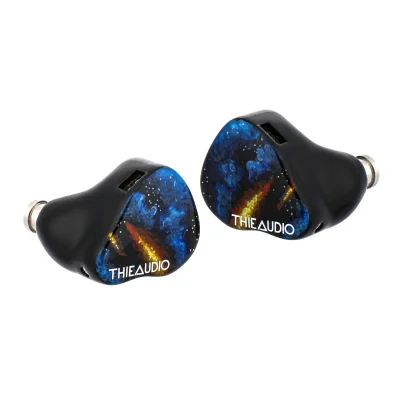Subtonic STORM and Thieaudio Origin use 5BA+2EST+2SLAM and 1DD+4BA+2EST+1BC driver setups respectively. Subtonic STORM costs $5,200 while Thieaudio Origin costs $849. Subtonic STORM is $4,351 more expensive. Subtonic STORM holds a decisive 1.2-point edge in reviewer scores (9.2 vs 7.9). Thieaudio Origin has slightly better bass with a 0.3-point edge, Subtonic STORM has slightly better mids with a 0.4-point edge, Subtonic STORM has significantly better treble with a 2.2-point edge, Subtonic STORM has better dynamics with a 0.5-point edge and Subtonic STORM has significantly better soundstage with a 1.5-point edge.
Insights
| Metric | Subtonic STORM | Thieaudio Origin |
|---|---|---|
| Bass | 8.7 | 9 |
| Mids | 8.4 | 8 |
| Treble | 8.7 | 6.5 |
| Details | 9.7 | 7.9 |
| Soundstage | 9.5 | 8 |
| Imaging | 9 | 7.9 |
| Dynamics | 9.5 | 9 |
| Tonality | 9.1 | 8.1 |
| Technicalities | 9.3 | 7 |
Subtonic STORM Aggregated Review Score
Average Reviewer Scores
Average Reviewer Score:
9.2Outstanding
Thieaudio Origin Aggregated Review Score
Average Reviewer Scores
Average Reviewer Score:
7.9Strongly Favorable
Reviews Comparison
Subtonic STORM reviewed by Jays Audio
Youtube Video Summary
Most IEMs inevitably introduce flaws that shatter musical immersion—be it harsh treble, shouty vocals, or unbalanced bass. These imperfections act as chains, binding the listener and preventing that elusive state of pure, uninterrupted freedom within the music. While the OG EJ07 came close, even it faltered on certain tracks, its forward vocals becoming a jarring distraction when pushed hard. The Subtonic Storm, however, shatters this pattern entirely.
Contrary to its name, the Storm represents the eye of the hurricane—a sanctuary of pure, effortless sound. It liberates the music from tuning flaws, presenting it naturally and tranquilly. There are zero distractions or attachments holding the listener back, enabling deep introspection and complete immersion, as if conversing directly with the singer or instrument. This profound, intangible quality—achieving that free state—is why it's considered the best IEM, offering unmatched resolution, separation, and imaging, albeit at an astronomical $5,000 price point.
Value-wise, the Storm is undeniably terrible; the KZ ASF ($250) gets you 80% there, and the Monarch MKII ($1,000) delivers 95%. It's a luxury item, justified only by its unique, unmeasurable ability to dissolve worldly distractions and forge total oneness with the music. Crucially, it's not for everyone: Bass heads, background listeners, or those enjoying J-pop/K-pop/EDM will find far better value elsewhere under $300. Only those deeply seeking musical transcendence, with ample disposable income, should even consider it. For everyone else, stay away—you simply don’t need it.
Jays Audio Youtube Channel
Thieaudio Origin reviewed by Jays Audio
Youtube Video Summary
Thieaudio Origin takes the “Meta” idea and dials it toward a fuller, bass-forward presentation without losing control. The bone conduction driver is not a gimmick—low notes carry palpable vibration and reverb while staying tight with clean layering and no mid bleed. Vocals sit naturally—neither shouty nor buried—though this isn’t a vocal-focused set (reach for RS5 if that’s the priority). Versus Oracle Mk II, the Origin trades some cleanliness for deeper tactility and weight, making bass textures feel more alive.
The top end is airy and extended on smooth Sonion ESTs, cutting through the warmth to balance the tuning. Most tracks are fine, but snare- and cymbal-heavy songs at higher volumes can push the treble into fatiguing territory (e.g., around 3:30 in Hikaru Utada’s “Time”). It’s generally controlled at moderate levels; just note that treble energy scales and can turn sharp when cranked.
In A/Bs, the Origin’s bass texture outclasses sets like Mega 5 EST, offering more detail, impact, and less boom. Against TITAN, Origin’s reverb and low-end “shake” edge it out while avoiding the Titan’s 5 kHz peak—though Titan still feels more exciting with livelier vocals. Versus all-rounders Monarch Mk II and Hype 10, those remain cleaner with better mids/layering but can’t match Origin’s sheer bass depth. The wildcard is BAJIE: stock, Origin wins; with EQ, BAJIE’s bigger 14.2 mm driver slams harder, while Origin stays the more balanced, tactile choice. Net: for a premium, fun, bass-centric daily driver under a grand, Origin sets a new reference—unless maximum slam with EQ is the goal.
Jays Audio Youtube Channel
Buy Thieaudio Origin on Linsoul
Ad
Price: $849
Buy Thieaudio Origin on Linsoul
Subtonic STORM reviewed by Tim Tuned
Youtube Video Summary
Subtonic STORM closes the list as the ultra-high-end, “one-and-done” pick—the kind of most expensive flagship that needs no hype because the name says it all. Chosen for a “versatile” roundup, it’s framed as the endgame option for those who want a single IEM to cover everything and have the budget to match—cue the playful “rich boys” jab.
The verdict is equal parts praise and pragmatism: demo first. STORM isn’t a blind-buy, and the price is so stratospheric it gets the tongue-in-cheek advice to sell a car, a house, or a kidney. In short, a summit-fi statement piece with serious one-set potential—but only after making sure the tuning truly clicks.
Tim Tuned Youtube Channel
Thieaudio Origin reviewed by Tim Tuned
Subtonic STORM reviewed by Head-Fi.org
Thieaudio Origin reviewed by Head-Fi.org
Subtonic STORM reviewed by Web Search
The Subtonic Storm delivers a balanced sound signature characterized by a generous sub-bass boost, neutral midrange, and an elevated, articulate treble response. Its standout feature is the implementation of proprietary SLAM drivers—custom balanced armatures handling separate sub-bass and mid-bass frequencies—which produce exceptional slam and texture rivaling dynamic drivers. The treble exhibits deliberate, controlled peaks between 5-15kHz, contributing to vividness without harshness, though some listeners may note a slight roll-off past 16kHz.
Technically, the Storm sets a high bar with class-leading dynamics, micro-detail resolution, and driver coherence across its hybrid array. Staging offers strong width and depth but lacks a cohesive center image. Ergonomically, the titanium shells are bulky and heavy, causing fatigue during extended use, and the stock cable is often criticized for stiffness. Additionally, its low sensitivity demands powerful amplification, limiting portability.
Thieaudio Origin reviewed by Web Search
The Thieaudio Origin delivers a bass-forward signature with a substantial 12dB sub-bass boost that provides visceral rumble and slam, particularly effective for electronic or hip-hop genres. Despite this emphasis, the neutral midrange avoids bloat, preserving vocal clarity and instrument separation, while the electrostatic drivers contribute a smooth, airy treble free from harshness or sibilance. Its technical performance is strong, offering a wide, holographic stage and precise imaging, though micro-detail retrieval falls slightly short of some competitors in its price tier.
Comfort is divisive due to the large shells, which may cause fatigue or fit issues for those with smaller ears, necessitating careful tip selection for optimal seal. The package includes a high-quality modular cable with swappable terminations (3.5mm/4.4mm) and a distinctive round Alcantara case, though the included ear tips may not suit all users.
Subtonic STORM (more reviews)
Subtonic STORM reviewed by Yifang
Youtube Video Summary
Subtonic STORM arrives as a spectacle: a limited run of 50 units presented in a hefty suitcase-style box that feels close to 2 kg. The unboxing greets with a personalized card and serialized plate—in this case marked “STORM 019.” Accessories are equally premium: a neatly organized tip case and a Singaporean handmade leather pouch crafted from aged Italian leather, signaling boutique attention to detail before the earphones even leave the case.
The earpieces show off a golden “stormy” faceplate evoking mythic cloud imagery, backed by hand-enameled black paint so meticulous that one in three plates is discarded to meet quality standards. Even the stock cable is positioned as ultra-high end, quoted at around $2,500 with an intricate crystal-lattice design. Price is acknowledged as “way too much money”, yet the presentation unabashedly stakes a claim as the world’s best IEM. This video stays focused on the unboxing and build; a full listening review is teased for a later date.
Yifang Youtube Channel
Subtonic STORM reviewed by Shuwa-T
Subtonic STORM reviewed by Precogvision
Precogvision Youtube Channel
Subtonic STORM reviewed by Gizaudio Axel
Gizaudio Axel original ranking
Gizaudio Axel Youtube ChannelSubtonic STORM reviewed by Smirk Audio
Subtonic STORM reviewed by Bad Guy Good Audio
Youtube Video Summary
Subtonic STORM lands as a $5,200 flagship built around novel SLAM balanced-armature tech: the dual BA “subwoofer” and “woofer” are separated and crossed over independently, joined by a regular BA mid-woofer, additional BA mids, BA mid-tweeter and tweeter, plus two EST—nine drivers total with a seven-point crossover. The result isn’t just another spec sheet; it’s a system that behaves like a rethought low-end engine that sets up everything above it.
On music, the bass ranks an honest 8/10 because it doesn’t sound like typical BA bass—there’s real weight without mid bleed, so male/female vocals, strings, and guitars stay pristine. Complex tracks reveal studio fingerprints: the 38 Hz triple drop on Big Boi’s “Kill Jill” slams; the glockenspiel in Springsteen’s “Born to Run” is crystal; Pink Floyd’s “On the Run” left-right sweeps and the early gate announcement snap into focus; Hendrix’s uneven production becomes obvious; and the Led Zeppelin IV kick-drum intro hits with the produced, swirling authority it should. From Vivaldi to hip-hop, it just handles the library.
Stage is spacious and speaker-like off good sources, with positional cues that outclass sets like Elysian Annihilator and even edge the Fatfreq Grand Maestro for resolution, stage, and tonality—though Grand Maestro’s multi-tuning keeps it competitive. Ignore treble “hacksaw” graph takes and target-chasing; the performance argues against strict adherence to Harman-style curves. Diminishing returns are real, but for those chasing something genuinely different, the STORM’s reworked BA low end and refined EST top end deliver a uniquely authoritative, all-genre presentation that’s hard to unhear.
Bad Guy Good Audio original ranking
Bad Guy Good Audio Youtube ChannelThieaudio Origin (more reviews)
Thieaudio Origin reviewed by Z-Reviews
Youtube Video Summary
Thieaudio Origin goes full mad-science: 1DD + 4BA + 2EST + bone conductor (eight drivers per side), big shells, hefty stock cable, and a tuning built around a ~12 dB sub-bass shelf. Fit can be a touch chunky, but foam tips (think Render) lock in seal and turn the low end from “more bass somewhere” into deep, anchored slam; silicone leaves it a bit loose. Accessories are barebones—swap plugs, tips, case—and that’s it. No fancy gifts, just a box of sound.
Sonically it’s a deconstructed presentation: instead of one smooth ribbon like a single DD, the Origin spreads the band across space—drivers carving out their lanes so instruments pop up here… then there… then over there. It’s not “mushy blend,” it’s forcible separation that can feel museum-exhibit surreal: treble details flit around (hello ESTs) while bass feels omnipresent and room-filling. It doesn’t really scale with amps; neutral DAC/amps to pricier rigs all keep roughly the same character. What can change the tonality is cable impedance—at 9 Ω and high sensitivity, cheap/high-resistance wires can skew things, so stick with a stout low-impedance lead.
Gripes? The cable is thick, custom faceplates up the bill, and the package isn’t exactly a Santa sack. But for $850, the payoff is a unique, spacious, “pulled-apart” soundstage that turns playlists into set pieces. Not for purists chasing one-driver cohesion; absolutely for listeners who crave clarity, staging theatrics, and tactile bass. Final word: a solid 9/10 on sound and swagger—price keeps it off the throne, excitement keeps it in the cart.
Z-Reviews Youtube Channel
Thieaudio Origin reviewed by Jaytiss
Youtube Video Summary
Thieaudio Origin brings a wild driver stack—1 DD + 4 BA + 2 EST + 1 bone conductor—inside a massive yet surprisingly comfortable shell. Build feels premium: striking faceplate, visible bone-conductor puck, proper nozzle lip, and a thicker cable than usual from the brand. The hockey-puck case is a nice touch, and for about $100 more there’s custom artwork available, making the unboxing and ownership experience feel a bit more special.
Sonically, this one swings for impact. Bass hits clean, strong, and fun, with upper mids that come across pristine. The trade-off: a hotter mid/treble band (around the 4–10 kHz region, with a notable 6 kHz glare) that can push cymbals and strings into an unnatural territory. Resolution and imaging don’t always keep pace for the price; stage is big and enveloping, but fine detail and separation can blur, making it a specialist that thrills on bass-centric tracks yet feels less convincing on metal or complex orchestral pieces.
Against its siblings, Origin sits like a more fun, bass-forward take compared with HYPE 4/10, but with a treble execution that’s less refined. Versus Oracle MK3, the latter’s ESTs sound crisper and cleaner; versus Monarch MKIII, that model’s tasteful 5–8 kHz dip lends better resolution. If pure detail is the target, sets like HiSenior Mega5 Bass or the Subtonic Annihilator may prove more satisfying. As a whole, Origin is a unique, bass-thrilled experience with excellent fit, huge space, and customization perks—great for those chasing visceral low-end and a cinematic stage, less ideal for listeners prioritizing treble finesse and microdetail at this tier.
Jaytiss Youtube Channel
Thieaudio Origin reviewed by
 Fresh Reviews
Fresh Reviews
Youtube Video Summary
Thieaudio Origin steps into the high end with a hybrid array—1DD + 4BA + 2EST + bone conduction—that pushes a richly textured, holographic presentation. The soundstage is wide and deep, imaging snaps into place, and the resolution clears the bar set by mid-tier sets. Most striking is the low-end: sub-bass digs deep with palpable rumble and impact yet avoids flooding the mix, leaving mids clean, detailed, and lifelike, and the treble airy with convincing cymbal sheen. At $850, the overall technical polish and bass quality feel appropriately premium—better than some kilobuck options.
For competitive gaming, the tuning translates across titles with ease. In Valorant, staging, separation, and distance cues deliver an A experience; occasional low-end bloom can introduce slight over/under flicks on sudden off-screen shots, but not often enough to dent performance. In Apex Legends, verticality and imaging impress (A-): during chaotic third/fourth-party fights, some lighter movement cues (slides, climbs) could cut through a bit more. In Warzone, depth and impact enhance immersion without masking key information, keeping imaging and separation strong. Tip rolling helps: foam trims bass and brightens; silicone restores slam.
Build and ergonomics match the sonic ambition: a galactic faceplate, sturdy 2-pin cable with swappable terminations, and a chassis that’s larger than average yet comfortable for long sessions (minor fatigue around the 6-hour mark). The nozzle is wide but short with a solid lip for secure tips. Overall, this is a fun yet precise set that excels in music and earns a high mark on a “wall-hack certified” style tier list for shooters—driven by standout bass, convincing staging, and top-tier separation.
Fresh Reviews original ranking
Fresh Reviews Youtube ChannelThieaudio Origin reviewed by Super* Review
Youtube Video Summary
At $850, Thieaudio Origin positions itself as an unapologetic bass icon with a complex driver stack (1DD/4BA/2EST plus bone conduction). Build and accessories are a mixed bag: the large, chunky shells will be too big for many ears, and the semi-transparent, pattern-heavy faceplates feel a bit generic. The thick stock cable suits the heft but the swappable plug mechanism is long, doesn’t lock, and often detaches at the adapter rather than the jack—an unnecessary annoyance. Fit is the major caveat; for smaller ears, contact is mostly at the tip, which compromises comfort and seal consistency.
Sonically, Origin is unmistakably bass-forward—well beyond Harman—with a warm, thick low end that initially reads as overbearing and soft on definition. With time, that bass takes on a distinctive, “ooey-gooey” atmospheric quality that sits under the mix rather than congesting it, enabling a surprisingly grand, spacious presentation. Above the lows, the tuning is “new-meta” adjacent: neutral-ish mids, balanced upper-treble, and a touch of mid-treble bite that sharpens transients and adds contrast. The trade-off is occasional edginess/sibilance on certain vocals, but guitars and percussion benefit from extra snap. Live recordings in particular gain scale and drama.
Against the Mega 5 EST Bass+ (cheaper, similarly boosted), Origin offers better separation and more engaging transients, while the Mega feels sludgier and less distinct—though also less edgy. Overall, Origin is a unique bass experience that prioritizes mood and scale over textbook bass tightness. The combination of fit challenges, polarizing low-end quality, and treble bite tempers enthusiasm, settling at a three-star (out of five) verdict—compelling for bass lovers seeking something different, but not a universal recommendation.
Super* Review original ranking
Super* Review Youtube ChannelSubtonic STORM Details
Driver Configuration: 5BA+2EST+2SLAM
Tuning Type: Neutral with Bass Boost
Brand: Subtonic Top Subtonic IEMs
Price (Msrp): $5,200
Support our free service! Buying through our affiliate links costs you nothing extra:
Thieaudio Origin Details
Driver Configuration: 1DD+4BA+2EST+1BC
Tuning Type: Neutral with Bass Boost, Basshead
Brand: ThieAudio Top ThieAudio IEMs
Price (Msrp): $849
Support our free service! Buying through our affiliate links costs you nothing extra:
Subtonic STORM User Review Score
Average User Scores
Average User Score: n/a
Based on 0 user reviews
No user reviews yet. Be the first one who writes a review!
Thieaudio Origin User Review Score
Average User Scores
Average User Score: n/a
Based on 0 user reviews
No user reviews yet. Be the first one who writes a review!
Subtonic STORM Gaming Score

Gaming Score & Grade
- The gaming score is prioritizing technical capabilities of the IEM (Separation, Layering, Soundstage) and good value.
Gaming Score
7.7Gaming Grade
AThieaudio Origin Gaming Score

Gaming Score & Grade
- The gaming score is prioritizing technical capabilities of the IEM (Separation, Layering, Soundstage) and good value.
Gaming Score
7Gaming Grade
A-Subtonic STORM Scorings
Average Technical & Tuning Grades
Average Tunign Grade
S- Expect a breathtakingly coherent response that elevates musicality and precision in equal measure. It highlights musical intent with uncanny clarity.
Average Technical Grade
S- Expect an effortlessly clean presentation that keeps complex mixes perfectly organized. There is zero sense of congestion even at high volume.
Thieaudio Origin Scorings
Average Technical & Tuning Grades
Average Tunign Grade
A+- Tuning feels refined, blending frequencies with convincing realism and engagement. Transitions between registers feel effortless.
Average Technical Grade
A-- The presentation feels orderly, balancing workable detail retrieval with acceptable imaging cues. It keeps momentum without smearing transients.
Subtonic STORM User Reviews
"This is an example review"
Pros
- Example pro 1
- Example pro 2
Cons
- Example con 1
- Example con 2
Share your experience and build your personal ranking list.
You need to be signed in to write your own reviewThieaudio Origin User Reviews
"This is an example review"
Pros
- Example pro 1
- Example pro 2
Cons
- Example con 1
- Example con 2
Share your experience and build your personal ranking list.
You need to be signed in to write your own reviewFind your next IEM:
IEM Finder Quiz
newIEM Comparison Tool
newVS



























